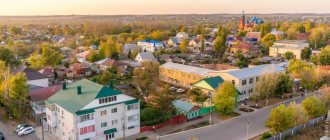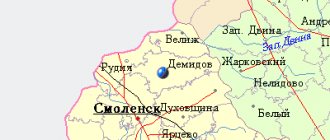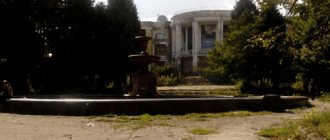This term has other meanings, see Shakhovskaya.
| Settlement Shakhovskaya Flag | Coat of arms |
| A country | Russia, Russia |
| Subject of the federation | Moscow regionMoscow region |
| Urban district | Shakhovskaya |
| Coordinates | 56°01′58″ n. w. 35°30′31″ E. d. / 56.03278° n. w. 35.50861° E. d. / 56.03278; 35.50861 (G) [www.openstreetmap.org/?mlat=56.03278&mlon=35.50861&zoom=12 (O)] (Z)Coordinates: 56°01′58″ N. w. 35°30′31″ E. d. / 56.03278° n. w. 35.50861° E. d. / 56.03278; 35.50861 (G) [www.openstreetmap.org/?mlat=56.03278&mlon=35.50861&zoom=12 (O)] (I) |
| Chapter | Gadzhiev Zamir Agarzaevich |
| First mention | 1901 |
| PGT with | 1958 |
| Population | ↘10,638[1] people (2016) |
| Timezone | UTC+3 |
| Telephone code | +7 49637 |
| Postcode | 143700 |
| Vehicle code | 50, 90, 150, 190, 750 |
| OKATO code | [classif.spb.ru/classificators/view/okt.php?st=A&kr=1&kod=46258551 46 258 551] |
| Official site | [www.shahadmin.ru/ hadmin.ru] |
| Shakhovskaya |
| Moscow Shakhovskaya |
| Shakhovskaya |
This article is about the workers' village. For the urban district, see Shakhovskaya Urban District; For the railway station, see Shakhovskaya (station).
Shakhovskaya
- an urban-type settlement, the administrative center of the Shakhovskaya urban district of the Moscow region. The status of an urban village has been since 1958.
Population - 10,638[1] inhabitants (2016).
The village is located on the M9
“Baltia”, in the west of the region, 136 km from the center of Moscow[2]. Shakhovskaya railway station on the Moscow - Riga line. The Kizel and Khovanka rivers flow within the village.
Story
The village was founded in 1901 in connection with the construction of the Moscow-Vindava railway, named in honor of Princess E. F. Shakhovskaya-Glebova-Streshneva.
On August 4, 1929, in connection with the formation of the Shakhovsky district, it became a regional center. In 1930, the first machine and tractor station in the region was organized. In 1935, a wooden hospital building was built. During the Great Patriotic War, in 1941, the village was occupied by the Germans, who held it until the counter-offensive of the Red Army in 1942.
In 1958, the first secondary school was opened. Since 1960, the first multi-story buildings began to be built (the tallest building to date is a nine-story building on Bazaev Street, built in 1990). In 1965, the House of Culture was rebuilt, where a children's music school was opened a year later, and in 1980 a local history museum was opened here. In 2011, a new museum building opened. In 1985, the village was supplied with gas.
On March 28, 1991, electric trains began running to Shakhovskaya. In 1995, the television was created. In 1998, the first line of the brick factory was launched, and the production of mineral table water began. From September 2003 to April 1, 2006, the largest electric lamp plant in Europe operated in Shakhovskaya.
2006—2015 — the administrative center of the urban settlement of Shakhovskaya, Shakhovsky district[3][4].
2015 - present V. — the administrative center of the Shakhovskaya urban district of the Moscow region[5][6].
Territorial structure of the region[ | ]
The Shakhovsky district included 1 urban-type settlement of regional subordination and 10 rural districts: Belokolpsky, Bukholovsky, Volochanovsky, Dorsky, Ivashkovsky, Kosilovsky, Ramensky, Seredinsky, Sudislovsky, Cherlenkovsky.
In 2006-2015 The Shakhovskaya municipal district included 4 municipalities, including 1 urban and 3 rural settlements:
| № | Municipality | Administrative center | Number of settlements | Population (persons) | Area (km²) |
| 1e-06 | Urban settlement: | ||||
| 1 | Shakhovskaya | working village Shakhovskaya | 10 | ↗11 610[4] | 38,69[5] |
| 1.000002 | Rural settlement: | ||||
| 2 | Ramenskoye | Ramenye village | 50 | ↘5308[4] | 366,75[5] |
| 3 | Seredinskoe | village of Sereda | 47 | ↘5242[4] | 428,91[5] |
| 4 | Stepankovskoe | Stepankovo village | 45 | ↗3533[4] | 384,53[5] |
Geography
The village has a forest, a dam, ponds and a park.
In 2002, a group of specialists from the Ministry of Natural Resources of Russia, the State Committee for Environmental Protection of the Moscow Region and Moscow State University published a report under the general editorship of Academician of the Russian Academy of Sciences G.V. Dobrovolsky and Corresponding Member of the Russian Academy of Sciences S.A. Shoba, according to which it is stated that in a number of In populated areas of the Moscow region, there is increased soil contamination with the radioactive isotope cesium-137. Among the 17 sites occupying no more than 10 percent of the region’s area is Shakhovskaya, where the pollution density reaches 2.0 / km² (with a norm of up to 1.5)[7].
Geography[ | ]
The area was located in the north-west of the Moscow region, 155 kilometers from the city of Moscow.
It bordered with the Lotoshinsky district - in the north and northeast, with the Volokolamsk municipal district - in the east and southeast, with the Mozhaysky municipal district - in the south, with the Gagarinsky district of the Smolensk region - in the southwest and west, as well as with the Zubtsovsky municipal district area of the Tver region - in the west and north-west.
The area at the time of abolition was 121,888 hectares[5].
Population
Population changes according to censuses and annual estimates:
| Population | ||||||
| 1926[8] | 1939[9] | 1959[10] | 1970[11] | 1979[12] | 1989[13] | 2002[14] |
| 859 | ↗3274 | ↗3698 | ↗5841 | ↗9375 | ↗10 393 | ↗10 439 |
| 2006[15] | 2009[16] | 2010[17] | 2012[18] | 2013[19] | 2014[20] | 2015[21] |
| ↘10 400 | ↘10 371 | ↗10 728 | ↗10 730 | ↘10 655 | ↗10 676 | ↗10 704 |
| 2016[1] | ||||||
| ↘10 638 | ||||||
Population[ | ]
| Population | |||||||
| 1931[9] | 1939[10] | 1959[11] | 1970[12] | 1979[13] | 1989[14] | 2002[15] | 2006[16] |
| 49 307 | ↘37 237 | ↘23 281 | ↘21 495 | ↗22 952 | ↗23 783 | ↘23 061 | ↗23 456 |
| 2009[17] | 2010[18] | 2011[19] | 2012[20] | 2013[21] | 2014[22] | 2015[4] | |
| ↗24 471 | ↗25 372 | ↗25 484 | →25 484 | ↘25 449 | ↗25 621 | ↗25 693 | |
According to the 2010 All-Russian Census, the population of the district was 25,372 people, including 12,027 men and 13,345 women; urban population - 10,728 people, rural - 14,644[23]. There are a total of 152 settlements (2010)[24].
Urbanization
At the time of its abolition in 2015, 41.7% of the district’s population lived in urban conditions (the workers’ settlement of Shakhovskaya).
Transport
- 1 (LPH - VAVS - Hospital)
- 32 (Shakhovskaya - Volokolamsk)
- 33 (Shakhovskaya - Ivashkovo)
- 34 (Shakhovskaya - Volochanovo - Kr. Bereg)
- 35 (Shakhovskaya - Sokolovo)
- 36 (Shakhovskaya - Novo-Alexandrovka)
- 38 (Lotoshino - Palkino)
- 39 (Lotoshino - Mikulino)
- 41 (Shakhovskaya - Berkunovo)
- 44 (Shakhovskaya - B. Sytkovo)
- 45 (Shakhovskaya - Lukoshkino)
- 46 (Shakhovskaya - Kozlovo - Shakhovskaya)
- 47 (Lotoshino - Zvanovo)
- 49 (Shakhovskaya - Babenki)
- 50 (Shakhovskaya - Repotino)
- 52 (Lotoshino - Torfyanoy)
- 53 (Lotoshino - Markovo)
- 55 (Shakhovskaya - Yadrovo - Shakhovskaya)
- 56 (Lotoshino - Novo-Vasilievskoye)
- 57 (Lotoshino - Pochinki)
- 58 (Lotoshino - Konoplevo)
- 61 (Lotoshino - Mikhalevo)
- 64 (Lotoshino - Zvyagino)
- 68 (Lotoshino - Streshnevy Gory)
- 70 (Lotoshino - Volodino)
- 130 (Shakhovskaya - Knyazhi Gory station)
- 464 (Shakhovskaya - Moscow (metro station Tushinskaya))
- 927 (Lotoshino - Tver)
- 961 (Moscow (metro station Tushinskaya) - Rzhev)
Notes
- ↑ 123
www.gks.ru/free_doc/doc_2016/bul_dr/mun_obr2016.rar Population of the Russian Federation by municipalities as of January 1, 2016 - [old.maps.yandex.ru/-/CVw97SLT Routes]. Yandex maps. Retrieved November 23, 2015.
- [mosobl.elcode.ru/page.aspx?25842 Law of the Moscow Region dated 02/28/2005 No. 62/2005-OZ “On the status and boundaries of the Shakhovsky municipal district and newly formed municipalities within it” (adopted by resolution of the Moscow Regional Duma dated 02/16/2005 No. 6/129-P)]. Retrieved January 21, 2014.
- [mosobl.elcode.ru/page.aspx?38786 Resolution of the Governor of the Moscow Region dated November 29, 2006 No. 156-PG “On the exclusion of rural districts from the records of administrative-territorial and territorial units of the Moscow Region”]. Retrieved April 17, 2014.
- [mosobl.elcode.ru/page.aspx?206272 Law of the Moscow Region dated October 26, 2015 No. 178/2015-OZ “On the organization of local government in the territory of the Shakhovsky Municipal District” (adopted by resolution of the Moscow Regional Duma dated October 15, 2015 No. 23/142-P )]. Retrieved January 3, 2016.
- [mosobl.elcode.ru/page.aspx?209016 Law of the Moscow Region dated November 25, 2015 No. 207/2015-OZ “On classifying the city of Egoryevsk, Egoryevsky District, Moscow Region, the city of Kashira, Kashira District, Moscow Region, and the city of Mytishchi, Mytishchi District, Moscow Region, as city of regional subordination of the Moscow region, classifying the working village of Serebryanye Prudy in the Serebryano-Prudsky district of the Moscow region and the working village of Shakhovskaya in the Shakhovsky district of the Moscow region to the category of an urban-type settlement of regional subordination of the Moscow region, abolition of the Yegoryevsky, Kashirsky, Mytishchi, Serebryano-Prudsky and Shakhovsky districts of the Moscow region and amendments to the Law of the Moscow Region “On the administrative-territorial structure of the Moscow Region” (adopted by resolution of the Moscow Regional Duma of November 19, 2015 No. 6/146-P)]. Retrieved January 3, 2016.
- [w[www.kp.ru/daily/22839.5/19250/ Radioactive zones of the Moscow region, article in the newspaper “Komsomolskaya Pravda” dated 02.29.2002]li>
- [d[dlib.rsl.ru/viewer/01003091360#?page=1 Directory of populated areas of the Moscow province]—Moscow Statistical Department. - M., 1929. - 2000 copies.
- [d[demoscope.ru/weekly/ssp/rus_pop_39_4.php All-Union Population Census of 1939. The size of the rural population of the USSR by regions, large villages and rural settlements - district centers] Retrieved January 2, 2014. [w[www.webcitation.org/6MJmNy0fn Archived from the original source on January 2, 2014]/li>
- [d[demoscope.ru/weekly/ssp/rus59_reg2.php All-Union Population Census of 1959. The size of the urban population of the RSFSR, its territorial units, urban settlements and urban areas by half]Russian). Demoscope Weekly. Retrieved September 25, 2013. [w[www.webcitation.org/6GDOghWC9 Archived from the original on April 28, 2013]/li>
- [d[demoscope.ru/weekly/ssp/rus70_reg2.php All-Union Population Census of 1970 The size of the urban population of the RSFSR, its territorial units, urban settlements and urban areas by gender.]Russian). Demoscope Weekly. Retrieved September 25, 2013. [w[www.webcitation.org/6GDOiMstp Archived from the original on April 28, 2013]/li>
- [d[demoscope.ru/weekly/ssp/rus79_reg2.php All-Union Population Census of 1979 The size of the urban population of the RSFSR, its territorial units, urban settlements and urban areas by gender.]Russian). Demoscope Weekly. Retrieved September 25, 2013. [w[www.webcitation.org/6GDOjhZ5L Archived from the original on April 28, 2013]/li>
- [d[demoscope.ru/weekly/ssp/rus89_reg2.php All-Union Population Census of 1989. Urban population][w[www.webcitation.org/617x0o0Pa Archived from the original on August 22, 2011]/li>
- [w[www.perepis2002.ru/ct/doc/1_TOM_01_04.xls All-Russian Population Census 2002. Volume. 1, table 4. Population of Russia, federal districts, constituent entities of the Russian Federation, districts, urban settlements, rural settlements - regional centers and rural settlements with a population of 3 thousand or more][w[www.webcitation.org/65AdCU0q3 Archived from the original source February 3, 2012]/li>
- [m[msu-mo.ru/userdata/docs/abc_np_03_08_06.zip Alphabetical list of settlements of municipal districts of the Moscow region as of January 1, 2006]RTF+ZIP). Development of local self-government in the Moscow region. Retrieved February 4, 2013. [w[www.webcitation.org/64cNVl25K Archived from the original on January 11, 2012]/li>
- [w[www.gks.ru/bgd/regl/B09_109/IssWWW.exe/Stg/d01/tabl-21-09.xls Number of permanent population of the Russian Federation by cities, urban-type settlements and districts as of January 1, 2009] Verified January 2, 2014. [w[www.webcitation.org/6MJmu0z1u Archived from the original on January 2, 2014]/li>
- [w[www.gks.ru/free_doc/new_site/perepis2010/croc/Documents/Vol1/pub-01-11.xlsx Population Census 2010. Population of Russia, federal districts, constituent entities of the Russian Federation, urban districts, municipal districts, urban and rural settlements]Rus.). Federal State Statistics Service. Retrieved February 9, 2013. [w[www.webcitation.org/6GDBk0rPa Archived from the original on April 28, 2013]/li>
- [w[www.gks.ru/free_doc/doc_2012/bul_dr/mun_obr2012.rar Population of the Russian Federation by municipalities. Table 35. Estimated resident population as of January 1, 2012] Retrieved May 31, 2014. [w[www.webcitation.org/6PyOWbdMc Archived from the original May 31, 2014]/li>
- [w[www.gks.ru/free_doc/doc_2013/bul_dr/mun_obr2013.rar Population of the Russian Federation by municipalities as of January 1, 2013. - M.: Federal State Statistics Service Rosstat, 2013. - 528 p. (Table 33. Population of urban districts, municipal districts, urban and rural settlements, urban settlements, rural settlements)] Retrieved November 16, 2013. [w[www.webcitation.org/6LAdCWSxH Archived from the original on November 16, 2013]/ li>
- [w[www.gks.ru/free_doc/doc_2014/bul_dr/mun_obr2014.rar Table 33. Population of the Russian Federation by municipalities as of January 1, 2014] Retrieved August 2, 2014. [w[www.webcitation.org/6RWqP50QK Archived from the original source August 2, 2014]/li>
- [w[www.gks.ru/free_doc/doc_2015/bul_dr/mun_obr2015.rar Population of the Russian Federation by municipalities as of January 1, 2015] Retrieved August 6, 2015. [w[www.webcitation.org/6aaNzOlFO Archived from the original source 6 August 2015]/li>
- [w[www.finiz.ru/news/article643866/ Financial News: Europe's largest electric lamp plant was opened in the Moscow region]li>
- [w[www.mosoblonline.ru/upload/att/20060330091707.pdf T. Sokratova, T. Dyudina.
The electric lamp is mothballed]/ Shakhovskie Vesti, No. 12 (80727), April 1, 2006
An excerpt characterizing Shakhovskaya (worker village)
Pierre could not understand for a long time, but when he understood, he jumped up from the sofa, grabbed Boris’s hand from below with his characteristic speed and awkwardness and, flushed much more than Boris, began to speak with a mixed feeling of shame and annoyance. - This is strange! I really... and who could have thought... I know very well... But Boris interrupted him again: “I’m glad I expressed everything.” Maybe it’s unpleasant for you, excuse me,” he said, reassuring Pierre, instead of being reassured by him, “but I hope I didn’t offend you.” I have a rule of saying everything directly... How can I convey it? Will you come to dinner with the Rostovs? And Boris, apparently having relieved himself of a heavy duty, getting out of an awkward situation himself and putting someone else in it, became completely pleasant again. “No, listen,” Pierre said, calming down. – You are an amazing person. What you just said is very good, very good. Of course you don't know me. We haven’t seen each other for so long... since we were children... You can assume in me... I understand you, I understand you very much. I wouldn't do it, I wouldn't have the guts, but it's wonderful. I am very glad that I met you. It’s strange,” he added, after a pause and smiling, “what you assumed in me!” - He laughed. - Well, so what? We'll get to know you better. Please. – He shook hands with Boris. – You know, I have never been to the count. He didn’t call me... I feel sorry for him as a person... But what to do? – And you think that Napoleon will have time to transport the army? – Boris asked, smiling. Pierre realized that Boris wanted to change the conversation, and, agreeing with him, began to outline the advantages and disadvantages of the Boulogne enterprise. The footman came to summon Boris to the princess. The princess was leaving. Pierre promised to come for dinner in order to get closer to Boris, firmly shook his hand, looking affectionately into his eyes through his glasses... After he left, Pierre walked around the room for a long time, no longer piercing the invisible enemy with his sword, but smiling at the memory of this dear, smart and strong young man. As happens in early youth and especially in a lonely situation, he felt an unreasonable tenderness for this young man and promised himself to make friends with him. Prince Vasily saw off the princess. The princess held a handkerchief to her eyes, and her face was in tears. - It's horrible! terrible! - she said, - but no matter what it costs me, I will do my duty. I'll come over for the night. He can't be left like that. Every minute is precious. I don’t understand why the princesses are delaying. Maybe God will help me find a way to prepare it!... Adieu, mon prince, que le bon Dieu vous soutienne... [[Farewell, prince, may God support you.] Adieu, ma bonne, [[Farewell, my dear,] answered the prince Vasily, turning away from her. “Oh, he’s in a terrible situation,” the mother said to her son as they got back into the carriage. “He hardly recognizes anyone.” “I don’t understand, mamma, what is his relationship with Pierre?” - asked the son. “The will will say everything, my friend; Our fate depends on him... - But why do you think that he will leave anything to us? - Ah, my friend! He is so rich and we are so poor! “Well, that’s not a good enough reason, mummy.” - Oh my god! My God! How bad he is! - exclaimed the mother. When Anna Mikhailovna left with her son to visit Count Kirill Vladimirovich Bezukhy, Countess Rostova sat alone for a long time, putting a handkerchief to her eyes. Finally, she called. “What are you talking about, dear,” she said angrily to the girl, who made herself wait for several minutes. – Don’t you want to serve, or what? So I'll find a place for you. The countess was upset by the grief and humiliating poverty of her friend and therefore was out of sorts, which she always expressed by calling the maid “dear” and “you.” “It’s your fault,” said the maid. - Ask the Count to come to me. The Count, waddled, approached his wife with a somewhat guilty look, as always. - Well, countess! What a saute au madere [[sauté in Madeira] there will be hazel grouse, ma chere! I tried; It’s not for nothing that I gave a thousand rubles for Taraska. Costs! He sat down next to his wife, resting his arms bravely on his knees and ruffling his gray hair. - What do you order, Countess? - So, my friend, what is it that you have dirty here? - she said, pointing to the vest. “It’s sote, that’s right,” she added, smiling. - That's it, Count: I need money. Her face became sad. - Oh, countess!... And the count began to fuss, taking out his wallet. “I need a lot, Count, I need five hundred rubles.” And she, taking out a cambric handkerchief, rubbed her husband’s vest with it. - Now. Hey, who's there? - he shouted in a voice that only people shout when they are sure that those they are calling will rush headlong to their call. - Send Mitenka to me! Mitenka, that noble son raised by the count, who was now in charge of all his affairs, entered the room with quiet steps. “That’s it, my dear,” said the count to the respectful young man who entered. “Bring me…” he thought. - Yes, 700 rubles, yes. But look, don’t bring anything torn and dirty like that time, but good ones for the countess. “Yes, Mitenka, please, keep them clean,” said the countess, sighing sadly. - Your Excellency, when will you order it to be delivered? - said Mitenka. “If you please know that... However, please don’t worry,” he added, noticing how the count had already begun to breathe heavily and quickly, which was always a sign of beginning anger. - I forgot... Will you order it to be delivered this minute? - Yes, yes, then, bring it. Give it to the Countess. “This Mitenka is such gold,” the count added, smiling, when the young man left. - No, it’s not possible. I can't stand this. Everything is possible. - Oh, money, count, money, how much grief it causes in the world! - said the countess. - And I really need this money. “You, countess, are a well-known reel,” said the count and, kissing his wife’s hand, he went back into the office. When Anna Mikhailovna returned again from Bezukhoy, the countess already had money, all in brand new pieces of paper, under a scarf on the table, and Anna Mikhailovna noticed that the countess was disturbed by something. - Well, what, my friend? – asked the Countess. - Oh, what a terrible situation he is in! It is impossible to recognize him, he is so bad, so bad; I stayed for a minute and didn’t say two words... “Annette, for God’s sake, don’t refuse me,” the countess suddenly said, blushing, which was so strange in her middle-aged, thin and important face, taking money out from under her scarf. Anna Mikhailovna instantly understood what was happening, and already bent down to deftly hug the countess at the right moment. - Here's to Boris from me, to sew a uniform... Anna Mikhailovna was already hugging her and crying. The Countess cried too. They cried that they were friends; and that they are good; and that they, friends of youth, are busy with such a low subject - money; and that their youth had passed... But the tears of both were pleasant... Countess Rostova with her daughters and already with a large number of guests was sitting in the living room. The Count led the male guests into his office, offering them his hunting collection of Turkish pipes. Occasionally he would go out and ask: has she arrived? They were waiting for Marya Dmitrievna Akhrosimova, nicknamed in society le terrible dragon, famous not for her wealth or honors, but for her directness of mind and frank simplicity of manner. Marya Dmitrievna was known by the royal family, all of Moscow and all of St. Petersburg knew her, and both cities, surprised by her, secretly laughed at her rudeness and told jokes about her; nevertheless, everyone without exception respected and feared her. In the office, full of smoke, there was a conversation about the war, which was declared by the manifesto, about recruitment. No one had read the manifesto yet, but everyone knew about its appearance. The Count was sitting on an ottoman between two neighbors who were smoking and talking. The count himself did not smoke or speak, but tilting his head, now to one side, now to the other, looked with visible pleasure at those smoking and listened to the conversation of his two neighbors, whom he pitted against each other. One of the speakers was a civilian, with a wrinkled, bilious and shaved thin face, a man already approaching old age, although dressed like the most fashionable young man; he sat with his feet on the ottoman with the air of a domestic man and, throwing amber far into his mouth from the side, impulsively inhaled the smoke and squinted. It was the old bachelor Shinshin, the countess's cousin, an evil tongue, as they said about him in Moscow drawing rooms. He seemed to condescend to his interlocutor. Another, fresh, pink, guards officer, impeccably washed, buttoned up and combed, held amber in the middle of his mouth and lightly pulled out smoke with his pink lips, releasing it in ringlets from his beautiful mouth. This was Lieutenant Berg, an officer of the Semenovsky regiment, with whom Boris rode together in the regiment and with whom Natasha teased Vera, the senior countess, calling Berg her fiancé. The Count sat between them and listened attentively. The most enjoyable activity for the Count, with the exception of the game of Boston, which he loved very much, was the position of listening, especially when he managed to pit two talkative interlocutors against each other.




